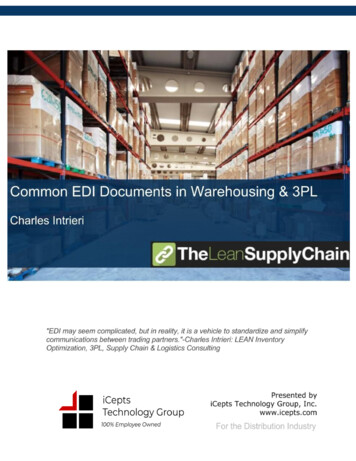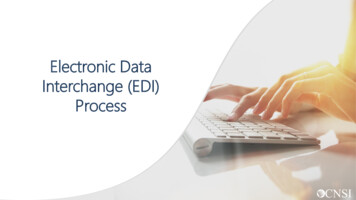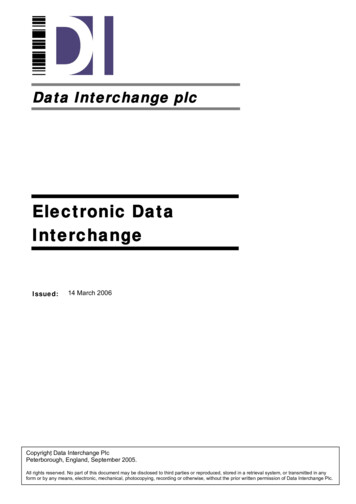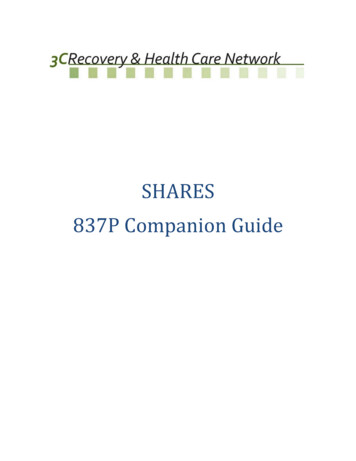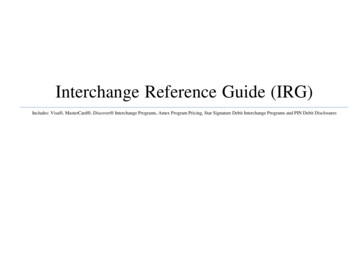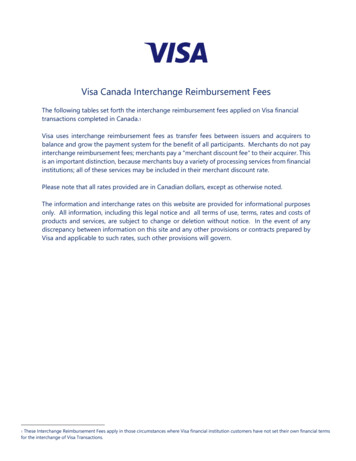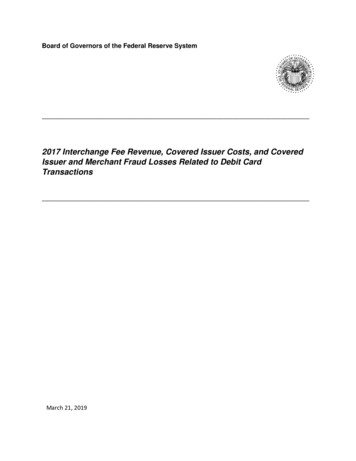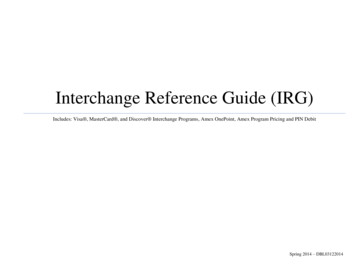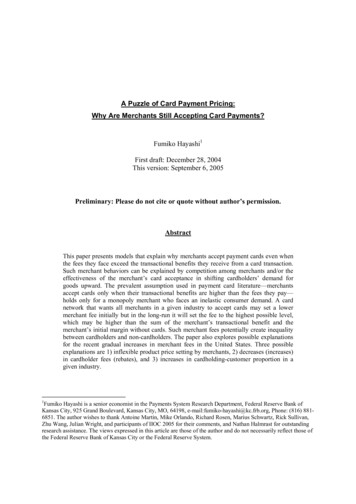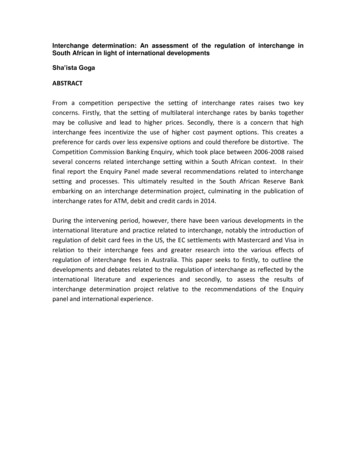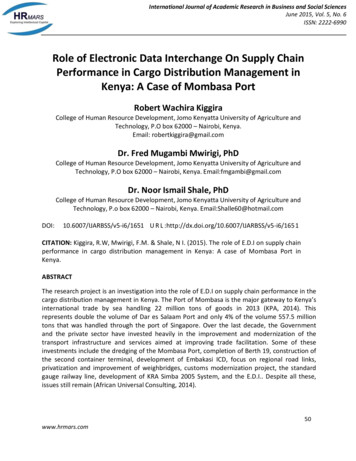
Transcription
International Journal of Academic Research in Business and Social SciencesJune 2015, Vol. 5, No. 6ISSN: 2222-6990Role of Electronic Data Interchange On Supply ChainPerformance in Cargo Distribution Management inKenya: A Case of Mombasa PortRobert Wachira KiggiraCollege of Human Resource Development, Jomo Kenyatta University of Agriculture andTechnology, P.O box 62000 – Nairobi, Kenya.Email: robertkiggira@gmail.comDr. Fred Mugambi Mwirigi, PhDCollege of Human Resource Development, Jomo Kenyatta University of Agriculture andTechnology, P.O box 62000 – Nairobi, Kenya. Email:fmgambi@gmail.comDr. Noor Ismail Shale, PhDCollege of Human Resource Development, Jomo Kenyatta University of Agriculture andTechnology, P.o box 62000 – Nairobi, Kenya. 6/1651 U R L :http://dx.doi.org/10.6007/IJARBSS/v5-i6/165 1CITATION: Kiggira, R.W, Mwirigi, F.M. & Shale, N I. (2015). The role of E.D.I on supply chainperformance in cargo distribution management in Kenya: A case of Mombasa Port inKenya.ABSTRACTThe research project is an investigation into the role of E.D.I on supply chain performance in thecargo distribution management in Kenya. The Port of Mombasa is the major gateway to Kenya’sinternational trade by sea handling 22 million tons of goods in 2013 (KPA, 2014). Thisrepresents double the volume of Dar es Salaam Port and only 4% of the volume 557.5 milliontons that was handled through the port of Singapore. Over the last decade, the Governmentand the private sector have invested heavily in the improvement and modernization of thetransport infrastructure and services aimed at improving trade facilitation. Some of theseinvestments include the dredging of the Mombasa Port, completion of Berth 19, construction ofthe second container terminal, development of Embakasi ICD, focus on regional road links,privatization and improvement of weighbridges, customs modernization project, the standardgauge railway line, development of KRA Simba 2005 System, and the E.D.I. Despite all these,issues still remain (African Universal Consulting, 2014).50www.hrmars.com
International Journal of Academic Research in Business and Social SciencesJune 2015, Vol. 5, No. 6ISSN: 2222-6990The objectives of the study are the roles of E.D.I corporate policies, employee training, andvolume of cargo processing and employee culture on supply chain performance in the cargodistribution management in Kenya’s Mombasa Port. The research used descriptive researchdesign as it provides information on the characteristics of the phenomenon. The populationwas 167 employees of the Mombasa Port and the population sample was 50 employees whowork at the operations department both at the office and in the field and amongst them,5 linemanagers were selected purposively . The response was 70% successful with a response of 35out of 50 respondents. The sampling design that was used is the stratified random. A pilot testwas done with the key informants before the full administration of questionnaire. Nevertheless,the researcher used questionnaires as the main method of data collection, although interviewsand observations were applied as well. Data was then analyzed using the quantitative anddescriptive statistics, then presented using tables and pie charts, whereas the quantitative datawas coded and data was be entered in SPSS for analysis. The findings from this study showedthat E.D.I plays a great role in the cargo distribution management at the Mombasa Port,although there are issues which include; inadequate non IT staff training, lack of trust of otherEDI partners, negative staff employee culture by some employees and stakeholders, morerequirements of changes in business requirements than expected, unforeseen technicalproblems and the system compatibility problems. In conclusion, a well adopted, planned andexecuted EDI roles and application process is necessary for the cargo distribution managementat the Mombasa Port.Keywords: Role, Electronic data interchange, Supply chain performance, Cargo distributionManagement, Kenya and Mombasa Port.IntroductionElectronic data interchange is the computer to computer exchange of business data in anagreed format (Noor, 2003).In addition to that, Electronic data interchange is the structuredtransmission of data between organizations by electronic means. It i s u s e d t ot r a n s f e r electronic documents or business data from one computer system to another i.e.from one trading partner to another trading partner without human intervention. It is morethan mare e- mail, for instance organizations may place bills of lading and even chaque with theappropriate EDI messages. It also refers specifically to a family of standards.Electronic data interchange is one of the most discussed business-to-business topics of today. Ithas become a tool for adapting and rendering business processes towards an integratedlogistics. Electronic Data Interchange (E.D.I) has been used as a technique for communicatingbetween different computer systems since the 1960’s. However, it took another 20 years forEDI to support different types of business processes (Lee, 2009). In the 1970's, severalindustries sponsored a shared EDI system that they usually turned over to a third partynetwork.51www.hrmars.com
International Journal of Academic Research in Business and Social SciencesJune 2015, Vol. 5, No. 6ISSN: 2222-6990Statement of the problemThe Port of Mombasa is the major gateway to Kenya’s international trade by sea handling 22million tons of goods in 2013 (KPA, 2014). This represents double the volume of Dar es SalaamPort and only 4% of the volume 557.5 million tons that was handled through the port ofSingapore. Over the last decade, the Government and the private sector have invested heavilyin the improvement and modernization of the transport infrastructure and services aimed atimproving trade facilitation. Some of these investments include the dredging of the MombasaPort, completion of Berth 19, construction of the second container terminal, development ofEmbakasi ICD, focus on regional road links, privatization and improvement of weighbridges,customs modernization project, the standard gauge railway line, development of KRA Simba2005 System, and the E.D.I. However, despite all these, challenges still remain especially thetransport inefficiencies at the Mombasa Port (Africon Universal Consulting, 2014). Thus thereason that necessitated the researcher to undertake the study.The port handles a mixture of containerized cargo, dry bulk cargo, general cargo and liquid bulkgoods consisting mainly of crude and petroleum products. In 2013, more than two thirds of theport throughputs amounting to 19,150 million Tons were imports accounting for 87% of thetraffic with transit cargo estimated at 30% (KPA, 2014). The Mombasa Port scores low in-termsof volume of business handled by international standards cargo dwell time which was 6.5 daysin 2011 to 5 days in 2012. Despite these improvements, the efficiency at the port of Mombasais still below the internationally acceptable standards of a maximum 3 days dwell time (EastAfrican Logistics Performance Survey, 2012).Objectives of the studyGeneral ObjectivesThe main purpose of this study was to analyze the role of E.D.I on supply chain performance incargo distribution management at the Mombasa Port.Research Objectivesi. To determine the role of E.D.I corporate policies on supply chain performance in cargodistribution management at the Mombasa Port.ii. To establish the role of E.D.I employee training on supply chain performance in cargodistribution management at the Mombasa Port.iii. To examine the role of E.D.I volume of cargo processing on supply chain performance incargo distribution management at the Mombasa Port.iv.To evaluate the role of E.D.I employee culture on supply chain performance in cargodistribution management at the Mombasa Port.Research questionsi. To what extent does the role of E.D.I corporate policies on supply chain performance incargo distribution management at the Mombasa Port?ii. What is the E.D.I employee training on supply chain performance in cargo distributionmanagement in at the Mombasa Port?52www.hrmars.com
International Journal of Academic Research in Business and Social SciencesJune 2015, Vol. 5, No. 6ISSN: 2222-6990iii.iv.Is there any role of E.D.I volume of cargo processing on supply chain performance incargo distribution management at the Mombasa Port?What is the role of E.D.I employee culture on supply chain performance in cargodistribution management at the Mombasa Port?Research scopeThe scope of this research was the employees of the Kenya Ports Authority at the MombasaPort in the Mombasa County, who work at the operations department. The organization itselfwhich is the K.P.A was accessed whether its use of E.D.I had a role to what extent in themanagement of cargo. The study was strictly limited to the Mombasa Port staffs of theoperations department both during the day shift and night shift who have been working for theorganization in the past five years and above.Literature reviewThis chapter on literature review focused on the various literatures on E.D.I. The literature wasreviewed from, working papers, journals, books, reports, periodicals and internet sources as italso presented a conceptual framework reflecting identified independent and dependentvariables. Electronic data interchange is one of the most discussed business-to-business topicsof today. It has become a tool for adapting and rendering business processes towards anintegrated process. Electronic Data Interchange has been used as a technique forcommunicating between different computer systems since the 1960’s. However, it tookanother 20 years for EDI to support different types of business processes (Lee, 2009).EDI emerged in the 1970’s primarily driven by the recognition that firms in transaction andeconomic relationships were wasting time and money printing, transferring and re-key interbusiness transaction data. To avoid this cumbersome process a group of firms collaborated andagreed on common formats and structures for exchanging computer- based data. Thisdevelopment meant that the information from points of sales terminals could now be linked tothe inventory management systems enabling the points of sale to keep up the minute track ofthe status of inventory (Vogt, 2002).Theoretical reviewThe theoretical framework of a project research relate to the philosophical basis on which theresearch takes and will form the link between the theoretical aspects and the practicalcomponents of the investigation being undertaken. The theoretical framework therefore “hasthe implication of every decision being made in the research” (Martens, 1998).Diffusion of innovation theoryDiffusion of innovation theory describes the process through which new ideas, practices, ortechnologies are spread into a social system (Rogers, 2004). Everett M. and Rogers 2004 werethe most prominent developer of diffusion of innovation theory. His book, Diffusion ofInnovations, was first published in 1962 and is now in its fifth edition. Formalized research onthe diffusion of innovations began in 1943 with a study by Bryce Ryan and Neal Gross, from the53www.hrmars.com
International Journal of Academic Research in Business and Social SciencesJune 2015, Vol. 5, No. 6ISSN: 2222-6990field of rural sociology, on the diffusion of hybrid corn in Iowa (Rogers, 2004). Diffusion ofinnovation theory has since spread to many different fields, and thousands of studies supportits tenets.The academic disciplines in which the theory has been applied include anthropology,communication, geography, sociology, marketing, political science, public health, andeconomics (Moseley and Rogers, 2004).Diffusion of innovation theory holds that innovation diffusion is “a general process, not boundby the type of innovation studied, by who the adopters are, or by place or culture” (Rogers,2004), such that the process through which an innovation becomes diffused has universalapplications to all fields that develop innovations. Diffusion is defined as “the process in whichan innovation is communicated through certain channels over time among the members of asocial system” (Rogers, 2004). An innovation is defined as “an idea, practice, or object that isperceived as new by an individual or other unit of adoption” (Rogers, 2004). Examples ofinnovations in the counseling profession include new and revised counseling techniques,theories, practice materials, assessment instruments, and technologies such as the Practice ofmanagement software.Resource based theoryResource based theory emphasizes that each firm is characterized by its own unique collectionof resources of core competencies. The source of competitive in the creation and exploitationof distinct capabilities that are difficult to build and maintain ,codify and make into recipes,copy and emulate and cant simply be bought off the shelf (Kenneth, 2012). Theory built on theresource-based view believes this postulate; i.e., IT can affect productivity but cannot directlyaffect firm profit, as IT is copied by other firms and therefore not a source of competitiveadvantage.This view states that sustained competitive advantage comes from resources that are valuable,rare, and imperfectly imitable. This view states that IT is neither rare nor imperfectly imitable; itcannot be a source of competitive advantage, and therefore cannot increase firm profits.However, RBV theorists believe that even though IT Expenditure cannot have direct effects onfirm profits, the combination of expenditure on IT and expenditure on other resources canjointly have an effect on profits Melville in 2004 develop a model of IT Business Value from theresource-based perspective, in which IT is combined with other organizational resources and isdeployed within business processes to improve business process performance, which in turncontributes to organizational performance (Melville et al 2004) make a significant contributionin developing an RBV based model. In this model, investing in Information Technology does notcreate value on its own; rather, the firm has to invest in other resources and the combination ofinvestments make the organization more productive and profitable. In addition, informationsystems implementations need considerable organizational change to succeed, includingadditional investments in other physical assets following the theoretical work; a few recentstudies have started looking for indirect effects of IT (Zhang et al, 2007).54
International Journal of Academic Research in Business and Social SciencesJune 2015, Vol. 5, No. 6ISSN: 2222-6990Transaction cost theoryThe transaction cost theory associated with Coase and Williamson, refers to the idea of the costof providing for some good or service if it was purchased in the market place rather than fromwithin the firm. Three key concepts are those of transaction costs, asset specifity andasymmetrical information distribution (Kenneth 2012). Asset specifity is the relative lack oftransferability of assets intended for use in a given transaction to other users.Asymetricalinformation distribution means that the parties to a transaction have uneven access to relevantinformation. One consequence is that, within a contractual relationship, either party mayengage in post contractual opportunism if the chance of switching to more advantageouspartnerships arises (Kenneth 2012).As companies tend to function more and more in networks (Castells, 1996), while supply chainstend to lengthen and become more complex, a broader application of transaction cost theorymay be required. While Information technology (E.D.I) is an instrument in reducing transactioncosts, the role of physical infrastructure itself should not be underestimated. The aim of thistheory is to show the importance of physical infrastructure for reducing transaction costs andthe use of transaction cost economics for analyzing supply chains. Transaction cost economics isstrictly related to the notion of governance, which is a broader concept than organization. Inthe economic context, management concerns different types of organizational structures whichrange from markets to different forms of hierarchies and networks involved in any kind ofeconomic activity (Platje, 2011).Management structures are a way to support cooperation andreduce any kind of conflict determined by the level of transaction costs. Transaction costs is aheuristic device analyzing how easy or difficult it is to make any type of exchange, whichbasically exist due to the measurement and information problems appearing due to theheterogeneity of goods while people are fallible, have limited cognitive abilities and tend tobehave opportunistically (Platje, 2011).55
International Journal of Academic Research in Business and Social SciencesJune 2015, Vol. 5, No. 6ISSN: 2222-6990Figure 1Conceptual frameworkE.D.I Corporate PoliciesEmployee E.D.I trainingCargo DistributionManagementVolume of cargo processingEmployee cultureIndependent variablesDependent variable56
International Journal of Academic Research in Business and Social SciencesJune 2015, Vol. 5, No. 6ISSN: 2222-6990Independent variable.E.D.I corporate policies.A Policy is a statement that describes in a very general terms the intended course ofaction. A policy serves as guidelines in making operating decisions that channel actions towardsthe achievement of objectives (Oxford dictionary, 2002).In relation to the E.D.I which isbasically integrative of the operations in an organization, its policies ought to be clear to theemployees of the organization that embraces the E.D.I for a proper operations managementdefined as design, operation and improvement of the systems that creates and delivers thefirms primary products and services (Richard, 2010).The Parties to a distribution agreementundertake to implement and maintain security procedures and measures to ensure theprotection of EDI messages against the risks of unauthorized access, alteration, delay,destruction, or loss. Security procedures and measures include verification of origin, verificationof integrity, nonrepudiation of origin and receipt, and confidentiality of EDI messages. EDImessages shall not be regarded as containing confidential information to the extent that suchinformation is in the public domain. The parties may agree to use a specific form of protectionfor certain messages such as a method of encryption to the extent permitted by law in either oftheir respective countries.Other E.D.I messages or other data transmitted to the other Party include personal data; suchdata shall be received, processed, and stored in accordance with the terms of the distributionagreement between the Parties, and the receiving Party agrees to comply with same for itsprocessing of the data. EDI messages with personal data originating in the European EconomicArea and transmitted to the receiving Party outside the EEA shall be processed by the receivingParty in accordance with a "safe harbor" arrangement or by adhering to the terms of a separatemodel data transfer agreement (Noor, 2003).Employee E.D.I trainingThis refers instilling competencies that are to be exhibited by an employee in undertaking a taskin relation to his/her occupation. In a given occupation, Training, qualifications and skills gohand in hand in the execution of responsibilities given to an employee with respect to his/herarea of work that is, may be an example of the Operations department (Torrington, 1991).Inputfrom employees and information on customer requirements is essential in maintaining cargodistribution management at the Mombasa Port. Computer applications allow organizations tobuild a data base to track customer satisfaction, analyze complaints, and obtain employee’sfeedback for ways to improve customer satisfaction. Employees in most institutions are usuallyopposed to introduction of computerized systems such as the electronic data interchange forfear of lack skills to use the technology (Armstrong, 2006). In order for computerization to beefficient, they have to be used by experienced personnel who have undergone training.Adoptions of computerized systems such as E.D.I require changing existing business processesto the “best practice” approach that the software embodies.Manpower planning is the57
International Journal of Academic Research in Business and Social SciencesJune 2015, Vol. 5, No. 6ISSN: 2222-6990“process by which management strives to have the organization move from its currentmanpower position to its desired manpower position (Armstrong, 2006). Through properplanning and training prior to the use of a computerized system such as the electronic datainterchange; the management strives to have the right time, doing things which result in boththe organization and the individual receiving maximum long-run benefit thereby improving thecargo distribution management.Volume of cargo processingBefore the implementation and adoption of KWFP, majority of the processes in the port ofMombasa were not automated. These processes include the submission of the hard copy vesselbay plans by the shipping agents to KPA, data collection process at the waterfront and othersites, container inventory management and the requirement of the mandatory six copies of theMombasa Port Release Order thus making the declaration process quite lengthy.Information inEDI form is exchanged between KPA and the other stakeholders through the United NationsElectronic Data Interchange for Administration, Commerce and Transport formats andsupplemented by private formats . The EDI files exchanged in the shipping industry includeBAPLIE for vessel bay plan, MOVINS for vessel pre plan, COARRI for d i s c h a r g e /Loading,CODECO for gate-out container logistic movements, CUSCAR for manifest and APERAKfiles for message receipt acknowledgement. Files are transmitted via email from the portusers to KPA and the users pick information relevant to them from KPA’s file transfer protocol(ftp) site. Other information is also available to the users through the web interface provided byKPA (Kilindini Waterfront Project, 2006).KWFP is a computerized information system that facilitates the running of the water front andcargo operations in the port of Mombasa. It was inaugurated on 10th January 2006and went live on 1st of July 2008. The project covers Container Terminal Operations,Conventional Cargo Operations, Marine Operations and the Inland Container Depots in Nairobiand Kisumu (Total Soft Bank, 2007). The stakeholders in this project are Kenya Ports Authority(KPA) which manages the Port of Mombasa, Kenya Revenue Authority under which customs fallsand Kenya Bureau of Standards who regulate the standards of t h e cargo passing throughthe port .Other stakeholders include Shipping Lines whose vessels call in the port of Mombasaand Clearing and Forwarding agencies that operate in the port (Magutu, Lelei and Nanjira 2010).Employee cultureInput from employees and information on customer requirements is essential in maintaining anefficient inventory management. Computer applications allow organizations to build a database to track customer satisfaction, analyze complaints, and obtain employee’s feedback forways to improve customer satisfaction (Harvard Business School, 1994).Employees in mostinstitutions are usually opposed to introduction of computerization for fear of lack skills to usethe technology. In order for computerization to be efficient, they have to be used byexperienced personnel.58
International Journal of Academic Research in Business and Social SciencesJune 2015, Vol. 5, No. 6ISSN: 2222-6990Implementing computer systems such as EDI require changing existing business processes tothe "best practice" approach that the software embodies (Khosrow et al, 2006).Manpowerplanning is the process by which management strives to have the organization to move from itscurrent manpower position to its desired manpower position (Eric, 2002). Through properplanning prior to computerization, the management strives to have the right time, doing thingswhich result in both the organization and the individual receiving maximum long-run benefitthereby improving the effective management of cargo at the Mombasa Port. Efficiency in thiscase in relation to the attitude of the employees will refer to the organizations Ability to useelectronic data interchange system that will allow customers to requisite for their cargo in realtime thus improving efficiency in terms of time saved moving from one department to theoperations department in an attempt to clear cargo.Dependent variable.Cargo distribution management.The Port of Mombasa is the gateway seaport for East Africa’s trading route. The port handles amixture of containerized cargo, dry bulk cargo, general cargo and liquid bulk goods consistingmainly of crude and petroleum products. In 2013, more than two thirds of the port throughputsamounting to 19,150mill Tons were imports accounting for 87% of the traffic with transit cargoestimated at 30%. A small container yard with a design capacity of 250,000 TEUs, cumbersomeclearance procedure; poor rail off-take resulted in clearance bottlenecks at the port. (KPAHandbook, 2014) The introduction of customs data interchange system and the containerfreight stations in 2005 to 2010 helped in reducing the bottlenecks at the port. The governmentinvestment in dredging at port, the development of berth 19 and the ongoing development ofthe new container terminal are some of the initiatives intended to clear the existing bottlenecksand revamp the port as the Port of choice in Eastern and Southern Africa region.The above mentioned improvements are expected to enhance trade volumes through the port.The recently launched standard gauge railway line from Mombasa to Nairobi is currently underimplementation and due for completion in 2017.This is expected to tremendously improve rail off-take at the port which according to Rift ValleyRailway (RVR) figures is currently at 5.4%. The current railway concession by RVR is alsoimproving with upgrade being undertaken to improve track, general infrastructure andequipment capacity. There is also planned roads up-grade around the Port which is at anadvanced stage. These include the Dongo-Kundu bypass and the realignment of the port exitroute. The Lamu South Sudan Ethiopia Transport Corridor (LAPSSET) is expected to relieveMombasa Port of the trade volume transiting to and from Ethiopia and South Sudan as well assome domestic cargo currently being handled by the Mombasa port. The LAPSSET Corridor iscurrently under the implementation with the first three berths due to commence construction.59
International Journal of Academic Research in Business and Social SciencesJune 2015, Vol. 5, No. 6ISSN: 2222-6990Critique of Existing LiteratureAlthough extensive research has generally been documented, few studies have beenundertaken in Kenya on the role of E.D.I on supply chain performance in the cargo distributionmanagement. (Magutu, Lelei and Nanjira, 2010) looked at the benefits and challenges of E.D.Iimplementation and application at the Kilindini Waterfront Project in Kenya. The study foundout that, despite the robust potential of the E.D.I system, it comes with both the benefits suchas access to information, standardized programs and improved trading partner relationship.Moreover, it has got challenges such as the high maintenance cost as well as inadequatefeedback from the E.D.I project managers. However little attention has been given to the roleof E.D.I on supply chain performance in the cargo distribution management.In addition, the role of E.D.I attributes to cost reduction and efficiency on supply chainperformance in the cargo distribution management, in spite of the challenges that its adoptionand application would confer to the organization and its stakeholders at large (Kenneth, 2006).Others studies which have been carried out include: (Philip, Joshua and Oluwagbemi, 2011)conducted a study aiming at the development of a window based security system for E.D.Iidentifying and proposing solutions to problems encountered in E.D.I applications; (Abubakar,Melati and gengeswari, 2008) studied the factors influencing the implementation of E.D.I; thisstudy accepts that the main purpose of E.D.I is to increase efficiency of all organizationalprocesses. The Researcher aimed to research on the role of E.D.I on supply chain performancein the cargo distribution management.However, the major challenges that were addressed by the study objectives have not beenadequately explored and this leaves some major gaps that will need to be filled by furtherresearch undertakings. This study has clearly established these gaps as; tangible costs and timegap. The research study therefore concentrated its research activities towards filling these gapsby identifying an appropriate solution to them.It was nimble and agile enough to respond to a market that is seeing growth driven primarily bynew products, good services and good technology. Research work done by other scholars in thisfield has not gone deep to analyze the role of E.D.I on supply chain performance the in cargodistribution management. The researcher went down and critically analyzed the role of E.D.I onsupply chain performance in cargo distribution management in Kenya, with reference to K.P.A,Mombasa. The Researcher established that a computerized system like E.D.I is a business toolthat integrates all the applications required by an organization as a whole, and connects theorganization to other enterprises in a network form. Computerized systems such as E.D.I areusually compromised of several modules such as: a financial module, a distribution module, oran operations module. Today, computers have added new functions such as supply chainmanagement, product dat
Electronic data interchange is one of the most discussed business-to-business topics of today. It has become a tool for adapting and rendering business processes towards an integrated logistics. Electronic Data Interchange (E.D.I) has been used as a technique for communicating between different computer systems since the 1960's.
